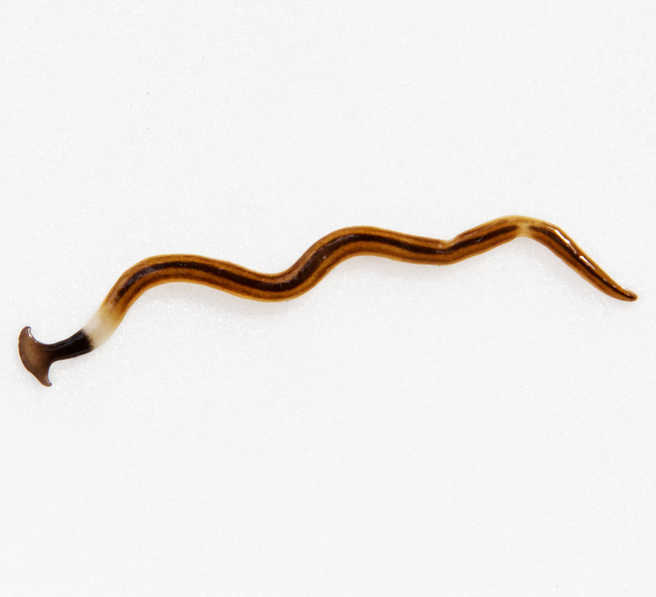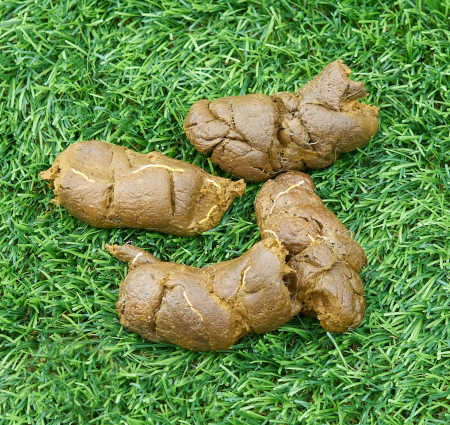
As a veterinarian, I deal with worms on a daily basis as they are such a common problem, particularly in young puppies. They can cause a wide range of symptoms and, thankfully, are usually easy to treat.
Our poor canine companions are quite prone to parasites, thanks to their lifestyle and penchant for eating things like soil, grass and even other dogs’ poop. In this article, we will review pictures of the most common types of worms (including pictures of these worms in dog’s stool and vomit).
What worms look like [with pictures]
Remember, not all worms are visible and some are too small to be seen with the naked eye. However, we can see some types of worms and these may be visualized in the poo or vomit.
1. Pictures of roundworms
These worms live in the dog’s intestine, feeding off the food that they ingest. They look like thick, cooked spaghetti and are the most common gastrointestinal worm we see in our pet dogs. These pale colored worms can grow very long; even up to 15cm in length, as shown on the pictures below.


Since most worms seen in dog vomit are roundworms, the color is usually white, light brown, or pale yellow. If you see something black or red, it likely is NOT an intestinal parasite. More than likely, what you see in the vomit is something your dog ate, like a stick or toy. It’s still worth collecting the sample to show to your veterinarian, though (At a minimum, remember to take a picture).
We see worms less commonly in vomit vs stool, as it is something that only tends to occur when a dog has a particularly heavy parasite burden. In practice, I see it most in young pups who have never received a de-wormer. Worms seen in dog’s vomit are typically white, thick roundworms that vary between 4-6 inches long. Less commonly, dogs can vomit tapeworms, which can be up to 11 inches.

If your dog has a roundworm infestation, you may indeed notice roundworms in their stool. The appearance of worms in the feces is often one of the signs that prompts pet owners to seek veterinary care. Roundworms in stool can look like this:

2. Pictures of tapeworms
These worms are segmented and light in color. If we see the individual ‘proglottids’ (segments) these look similar to a grain of rice. The tapeworm itself can grow very long; up to 30 inches.


However, tapeworms are not often seen in complete worm form. Usually, owners will notice individual tapeworm segments that look like a single grain of rice. These may be around the dog’s anus, sticking to the surrounding fur, or even in the dog’s bed.
Below is a picture of tapeworms in a dog’s poop:

Sometimes the segments cause the dog to rub their butt along the ground. However, scooting like this is not always a sign of worms and more common causes include food allergies and anal gland disease.
3. Pictures of hookworms
Hookworms are much smaller than the two preceding worms discussed. They only grow to about 2cm long (less than an inch) so are easily missed and not often seen.


When looked at under the microscope, we can see a gaping mouth with very sharp teeth, which they use to attach to the intestine and suck blood from the dog.

4. Pictures of Whipworms
As with hookworms, we would not generally expect to see whipworms without a microscope. Indeed, these are the smallest of the 4 common intestinal worms, growing to about 6mm in total. They get the name ‘whip’ worm due to the fact that they are slimmer at one end. As with the other worms, they are a pale or white color.

Below is a picture of what whipworms in a dog’s poop look like:

Female whipworms intermittently shed small numbers of eggs, meaning the eggs may not always be seen on a fecal test when looking for parasites, even if the dog is infected; this often leads to a false negative. It helps to do a ‘pooled poop sample’ whereby we analyse the poop passed over 3 days, to try and detect any parasites.
Often, vets treat dogs with chronic diarrhea with a broad-spectrum dewormer if an intestinal parasite is suspected but not seen on the fecal test.
A large infestation of whipworms may show the following symptoms:
- Watery, bloody diarrhea
- Weight loss and decrease in body condition overall
Signs that your dog has worms
The signs your dog displays will depend on the type of worms they have and how heavy their parasite burden is. Interestingly, those with worms may have no signs at all. Some of the more common symptoms I see in my patients include:
- Loose stool
- Bloody stool
- Abdominal bloating
- Weight loss
- A dull coat
- Excess hunger
- Vomiting
How bad is it for a dog to get worms?
While quite an unpleasant thing to contemplate, worms are usually not a serious diagnosis and most dogs cope very well with an infestation.
An exception would be a very heavy worm burden in a young pup, especially if we are dealing with hookworm. A severe infestation can lead to anaemia, failure to gain weight and even gut obstructions.
Can any dog get worms?
Any dog can develop worms and they can be spread from their mother or from other dogs. They can be picked up both from the dog’s environment and from their food. Interestingly, studies have shown that those who go to dog parks are at higher risk for catching worms (1).1
Prognosis
The prognosis for intestinal worms is excellent. They are easily treated and soon resolve. Dogs should make a full recovery. Most medicine gets to work within a few hours and dogs are worm free within just a few days.
Typical treatments
There are a huge range of wormers available on the market, making it tricky for owners to know which one to plump for. When possible, pick one that has been recommended by your vet.
Some common oral wormers include Fenbendazole, Febantel and Praziquantal. These should be used routinely, to prevent worm burdens((AAHA Parasite Control)).
Be wary of more ‘natural’ products that are not proven to work, as they may not eliminate the issue. I have even seen some websites even suggest using garlic as a natural de-wormer, which is highly toxic to dogs and should never be given.
Does my dog have worms or could it be something else?
While worms are a common cause of signs like diarrhea and bloating, there can be many other conditions which mimic worms. This can include bacterial infections of the gut or colitis (an inflamed colon).
It is always sensible to confirm the suspected diagnosis at a vet clinic, before starting treatment. The vet may discuss a stool analysis to check for worms, or might have such a high suspicion for worms that they will go ahead and treat for them without confirming a diagnosis.
Can worms be treated with over-the-counter medicine?
Absolutely, yes. There are a range of OTC treatments available that are effective. Owners need to ensure the type they’re using is effective for the worm the dog has, and that the correct dose is used.
Panacur
My all time favorite OTC wormer is Panacur
No products found.
This wormer is licenced to treat all four of the most common worms (whipworm, hookworm, tapeworm and roundworm) and also has some efficacy against other parasites such as Giardia.
This particular linked product is a powder, which mixes easily into food and works well for dogs of all ages. In pups, it can be used from 2 weeks of age.
Quad Dewormer
Here is another good wormer which is broad-acting.
It contains a mix of ingredients: Praziquantel, Pyrantel and Febantel. This ensures it is effective against all 4 of the most common canine intestinal worms.
Available in tablet form, some owners find this formulation less messy than the powder.
Signs that you need to call the veterinarian
Most cases of worms will not need urgent vet attention and the dog should remain otherwise well. However, if the dog’s signs are persisting despite a wormer or if the dog seems unwell, then a vet check is wise.
Young puppies are most likely to become unwell and we’d want them seen by their vet if they’re less active than usual, not growing as expected or experiencing vomiting or blood in their poo.
Will a vet be able to help over a video call?
Sometimes a video call would be useful, yes. You can talk through your dog’s signs and email across any photos of worms you’ve seen, puddles of vomit or diarrhea. The drawback is that the vet cannot assess your pet in person, or run any tests such as a stool analysis.
Still, they’ll usually be able to help discuss at home care options include what diet to offer and which wormer to provide.
Your visit at the vet
What you should know before your visit
It is a good idea to being a stool sample along with you when possible. The most useful stool sample is one that consists of three different stools, passed at different times. This is called a pooled sample and can help with the detection of worms as they will not always be present in every stool passed.
Diagnosis & cost of diagnosis
Worms are usually easily diagnosed with a stool analysis and should be inexpensive to treat. Indeed, wormers range in price from about $5 to 20.
- https://www.avma.org/javma-news/2020-10-01/study-finds-parasites-common-dog-parks
- https://www.aaha.org/aaha-guidelines/life-stage-canine-2019/parasite-control/
- JAVMA News, Study finds parasites common in dog parks [↩]
Disclaimer: This website's content is not a substitute for veterinary care. Always consult with your veterinarian for healthcare decisions. Read More.



Good morning my dog have blood in his poop he is 6 years old.since Friday this have been happening.i don’t have transportation to take him to ASPCA I WANT TO KNOW WHAT IF HE HAVE WORMS WHICH WORM MEDICINE CAN I ORDER ONLINE FOR HIM .IM SCARED I CANT STOP CRYING I DONT WANT MY FUR BABY TO DIE .
Hi Yualanda and thank you for your post. I’m so sorry to hear about your dog’s medical issue and can appreciate how worrying this must be.
Bloody stool in a dog of his age is less likely to be caused by parasites, though it is possible. We’d also have to consider e.g. a bacterial or viral infection, a recent toxin ingestion, liver disease etc.
Please discuss any financial concerns with your vet so they can work with you and keep costs down.
Many vets allow payment on credit and some also offer payment plans.
Your vet may also know of local charity vets who you are eligible to use.
If transport is an issue, perhaps you could use a pet taxi company, or ask a friend or neighbour for a lift.
In answer to your question, a broad acting wormer like Drontal Plus or Panacur can be bought over the counter.
It is also wise to stick to a bland diet (such as chicken and rice) and to encourage water drinking.
As I say though, bloody stool is something that would warrant a vet visit.
Hopefully he is better very soon.
“The information on this website is not a substitute for in-person veterinary care. Always seek advice from your veterinarian if you have concerns about your pet’s medical condition.”